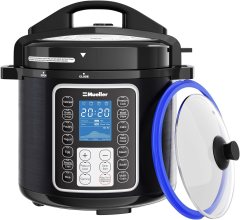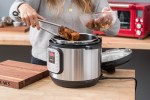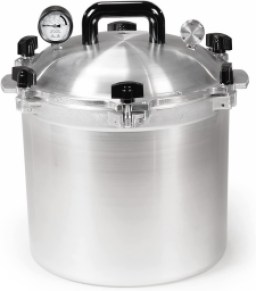Buying guide for Best pressure cookers
If you like cooking for guests but dislike the amount of time it takes, you may want to invest in a pressure cooker. Using high-pressure steam, a pressure cooker can prepare tough meats in a matter of minutes. Pressure cookers can also steam vegetables, make soups and stews, cook rice and beans, and even make chili.
With the popularity of this versatile all-in-one machine, there are plenty of different models to choose from. However, before you commit to purchasing a pressure cooker, you should consider the capacity you need and the versatility it offers, which is often apparent by the number of settings available for cooking different meals. Also consider the weight, user-friendliness, and durability of this kitchen appliance.
Our team evaluates electric and stovetop pressure cookers to determine which models provide the best results and high value.
We look for pressure cookers that heat food rapidly and thoroughly with minimal effort.
We appreciate pressure cookers that can also bake cheesecake and other desserts with ease.
Pressure cookers are great for cooking meat or veggies. We examine different models to find the most versatile choices.
We note the extra functions and features offered to find the best pressure cookers for our shortlist.
As the name suggests, pressure cookers operate under extremely high pressure that can be dangerous if handled improperly. We look for models that can be opened safely.
We are drawn to pressure cookers that are easy to use by both beginners and seasoned pros. Effortless cooking is the name of the game.
We give bonus points to pressure cookers that come with handy extras, such as steaming trays and nonstick springform pans.
We look for pressure cookers with PTFE-free and PFOA-free hardware.
Our team looks for pressure cookers that are durable enough to last a long time. The goal is for consumers to find the best value for their investment.
How pressure cookers work
In a manner somewhat similar to braising, a pressure cooker prepares food using steam that is tightly sealed in a special pot.
- Liquid in the form of water, stock, broth, or even wine is heated in the sealed chamber, which creates steam.
- The airtight seal creates a large amount of pressure inside the pot, which heats the liquid to a high temperature.
- Once the lid is closed, the correct amount of pressure is selected based on the recipe.
- The pot is placed on the stove on very high heat until it reaches the desired pressure. Pressure level is indicated in various ways depending on the cooker; it can be a digital readout or manual gauge.
- When the desired pressure is reached, the heat is lowered to maintain a consistent pressure. It can take up to 10 minutes for a pressure cooker to reach its target temperature.
Expert tip
Avoid using dairy (like creamy sauces) in your pressure cooker. The high heat can cause milk-fat solids to curdle and clump together.
BestReviews Cooking and Baking Expert
When cooking is finished — but before the lid is opened — the pressure inside the pot must be released. That process can be done in one of three ways:
Quick release: The steam valve is gently turned so the heat can escape.
Natural release: The heat is turned off, and the pot is allowed to cool for 10 to 15 minutes before lid removal.
Cold-water release: The pressure cooker is placed under running cool water. This is the most dangerous method of pressure release, as steam can escape from vents accidentally left open.
How to BBQ with a pressure cooker
Better taste, better nutrition – faster, easier
Many people eat pressure-cooked food because they believe it’s healthier, tastier, easier, and faster to prepare.
Indeed, a pressure cooker’s combination of steam and pressure speeds up the cooking process while simultaneously preserving key nutrients and vitamins. What’s more, the end results taste great.
Pressure cooker history
First-generation pressure cookers
If you model your kitchen after your grandmother, there’s a pressure cooker that’s just right for you. Generally found at garage sales or on Craigslist, these first-generation pressure cookers require careful monitoring, but they can get the job done perfectly.
The earliest pressure cooker models have a weight on the top of a valve that releases steam during the cooking process. The drawback is that there is no gauge, so everything cooks at the same temperature.
Toward the end of this first generation of pressure cookers, some manufacturers made weights of varying sizes that allowed cooks to monitor the pressure. Cooking time would then be based on the number of long “whistles” that issued from the pressure cooker. For example, when the cooker gave off seven whistles, your pot roast was done.
Second-generation pressure cookers
The second generation of pressure cookers had a built-in gauge that could be adjusted to the desired pressure. Often, these appliances had two or more settings. In many cases, there was no release valve, which meant home cooks had to be extra careful in how they released steam before opening the lid.
Pressure cookers in the ‘90s and beyond
In the early ‘90s, electric pressure cookers hit the market. These appliances allowed users to regulate both heat and pressure. As technology improved, electric pressure cookers advanced in stages.
Stage one: Market offerings had a manual timer. There was no such thing as a programmable pressure cooker with helpful presets at this time.
Stage two: The market began to offer programmable pressure cookers that included digital timers with delayed cook settings.
Stage three: The market began to offer smart digital functions that enable detailed setting control. Stage three also introduced the multifunctional model which, in addition to offering multiple pressure settings, functions as a rice cooker, steamer, yogurt maker, and stock pot.
Expert Tip
Don’t overfill the pressure cooker – too many ingredients and/or liquid can cause uneven cooking.
BestReviews Cooking and Baking Expert
What to cook in your pressure cooker
While it’s true that you could cook just about anything in a pressure cooker, some foods and recipes lend themselves better than others to this fast, high-heat style of preparation.
Pot roast
Though a good pressure cooker pot roast recipe may require a fair amount of prep work (including browning the meat and sautéing the vegetables), you’ll have a hearty dinner that will no doubt please family and guests after about 45 minutes in an electric pressure cooker. Notably, one of the key benefits of cooking with steam pressure is that it allows users to find success with less expensive (tougher) cuts of meat.
Chili
A bit of advanced prep is required for chili — mostly browning the meat and removing excess fat. But once all ingredients are placed in the pot, the pressure cooker works quickly (in about eight minutes) to create a chili to remember.
Soup or stew
Do you love soup and stew? If you choose, you can use your pressure cooker to kick up a traditional vegetable soup with a little added protein in the form of chicken or, if your tastebuds are watering for it, hearty beef stew. If you’re lucky enough to have a multifunction pressure cooker, you can perform the vegetable and meat sauté work in one pot. Once all the ingredients are in place, cooking time is a quick 15 minutes on high.
Cheesecake
Yes, you can make cheesecake (as well as other desserts) in a pressure cooker. According to many recipes, the cooking is actually done using steam while a springform or other pan is placed on a trivet or makeshift foil lift. The steam surrounds the pan during the 40-minute cooking time.
Did you know?
Pressure cooking helps veggies retain between 90 and 95% of their vitamins as compared to boiling, which can cut vitamin content in half.
STAFF
BestReviews
Safety first
Calamities are bound to happen in any kitchen activity, but the heat and pressure that builds up in a pressure cooker necessitate a number of safety-first rules.
- Make sure the rubber gasket seal is intact. Many manufacturers suggest you replace the rubber gasket annually, but it may be wise to keep a spare on hand. A broken or chipped gasket will prevent the appliance from sealing tightly, which could cause it to open unexpectedly.
- Do not put too much food in the pressure cooker. The heat will cause the food to expand, so don’t fill the inner pot more than half full. Opening the inner pot when it is overflowing with food could lead to severe burns.
- Add enough water. An inadequate amount of water could lead to an imbalance in pressure, which could in turn lead to burnt food.
- Do not fry in your pressure cooker. The heat from too much oil in the pot could damage the valve and other parts of the appliance.
- Be extra careful during steam release and when opening the lid. There is no formal tally of pressure cooking accidents, and with newer digital models, they may be less frequent. Nevertheless, you should always read the directions of your unit before using it. See the aforementioned methods for safe steam release and opening the cooker lid.
- Do not open a pressure cooker while it is operating. Doing so would pose a significant safety hazard. If you must open up the cooking vessel, unplug it first.
At one point, pressure cookers were limited to rapidly braising cheaper cuts of meat. With a refresh and a few semiconductors added, the pressure cooker’s range now includes the slow cooking of soups, the rapid preparation of dried beans, and much more.
STAFF
BestReviews
Features to look for in a pressure cooker
Capacity
How much food do you want to be able to prepare at once? This is reflected in the number of quarts a unit can hold. Many of the best ones we’ve seen hold around 6 quarts of food, but you can find smaller 2-quart models, extra-large 8-quart models, and many stops in between.
If you’re feeding just yourself and maybe a housemate or two, a 4-quart model may be ideal. If you entertain often and want the ability to prepare large batches of chili, cheesecake, or other pressure-cooked foods, opt for an 8-quart capacity or greater.
Notably, electric pressure cookers often have a larger capacity than their traditional counterparts.
Versatility
Some pressure cookers are basic machines designed for beginners who simply want to saute veggies, sear meats, and prepare stews and a few other types of foods. These machines cost less than the more involved multi-cookers addressed here.
A multi-cooker offers multiple cooking functions. In other words, it can do more than just pressure cook. You may be able to use it as an air fryer, a slow cooker (like a Crock-Pot), a yogurt maker, a rice cooker, and more.
If you’d like a quick example of what we’re talking about here, think of an Instant Pot. A model like the Instant Pot Duo combines seven different functions in one machine. These gadgets cost a bit more than basic pressure cookers, but many people decide that if they’re going to put a new item on their countertop, they’d like it to be something that offers several unique cooking functions.
Materials and appearance
Pressure cookers may be made with an outer housing of stainless steel or aluminum. We advise potential buyers to look for appliances with stay-cool handles, a fingerprint-resistant finish, and if possible, a stay-cool housing.
The inner pot, or chamber, of a pressure cooker is often made of a nonstick material. Nonstick cookware is much easier to clean and is often dishwasher safe. Check the instructions and user manual before you wash your new appliance for the first time.
Many of the most popular pressure cookers today are made of stainless steel with black trim. They may have an LCD screen or a set of buttons for easy operation.
Did you know?
The cold-water release method is best for foods with shorter cooking times, like vegetables. For example, the cold-water release method works well for broccoli, which can cook in just two minutes in a pressure cooker.
STAFF
BestReviews
How much do pressure cookers cost?
Under $50
A traditional pressure cooker, generally made of aluminum, can be found in this price range. Generally smaller in capacity — between 8 and 16 cups, in many cases — these pressure cookers have safety features built into the handles and release valves. They lack precise gauges to control the amount of pressure, but they are suitable for small families and those who don’t plan to use the unit on a regular basis.
You might start by looking at the offerings from budget-focused brands like Presto and t-fal.
Under $100
Climbing up the price ladder, we begin to find large electric pressure cookers, some with capacities of more than one gallon. Here you will find stovetop pressure cookers that have the same features as their aluminum counterparts but are made of stainless steel. Closer to the $100 mark, you can find some of the more recognizable names in pressure cookers, such as Cuisinart and Ninja Foodi.
Under $200
For under $200 — and sometimes less than $100 — you can grab yourself a popular Instant Pot that performs other functions beyond pressure cooking, such as sautéing. The price will vary depending on capacity and smart WIFi-based features, such as Bluetooth capability. You can also find great offerings from brands like Cuisinart and Ninja Foodi here.
You might expect to get the benefits of a Crock-Pot or an Instant Pot when you spend this much, especially if you pay upwards of $150 or perhaps more than $200.
Read your instruction manual carefully before operating your new pressure cooker. Although today’s pressure cookers have many more built-in safety features than those of your grandparents’ day, injury is still possible. Stay safe and read the manual.
STAFF
BestReviews
FAQ
Q. Why do some pressure cookers come with a trivet, basket, or rack?
A. These accessories increase your ability as a home cook to prepare certain foods. For example, an Instant Pot often comes with a trivet or other type of rack that holds your food above the liquid inside the inner pot. You can use this rack to make delectable ribs, cheesecake, lasagna, and more within the cooking chamber.
Using a trivet essentially allows food to be steamed without being submerged in liquid. You get the benefits of steam cooking without the drawbacks of drenching your food. Many people find their food retains more flavor when prepared this way.
Q. Can I sterilize baby bottles or canning jars with my pressure cooker?
A. Some people use their pressure cookers to sterilize bottles and jars. The high temperature of the steam works well to kill germs and prepare the sterilized vessels for their next use. However, if you decide to use your pressure cooker to sterilize baby bottles, experts recommend that you reserve your appliance for this purpose only.
If you would prefer to reserve your pressure cooker for cooking tasks only, consider investing in a baby bottle sterilizer. These gadgets are inexpensive, highly useful, and make great baby shower gifts.
Expert tip
I wouldn’t recommend using your pressure cooker to make a pie. Dry heat is required to make that crispy flaky crust, so stick to your traditional oven for pies.
BestReviews Cooking and Baking Expert
Q. What if I want a plain pressure cooker without added bells and whistles?
A. When shopping, pay attention to which cooking functions are offered by any product you consider. If your goal is strictly to pressure cook food, you’re probably not interested in reading about the best Instant Pot, and you probably don’t want to buy a multi-cooker with air frying or dehydrating capabilities like the Instant Pot Pro.
That’s okay. Just know that the market is saturated with both options: entry-level pressure cookers and multi-cookers with lots of “bells and whistles.”
You’ll be pleased to know that a traditional pressure cooker without the added features costs much less than an Instant Pot and similar appliances. However, it’s worth noting that an Instant Pot isn’t that much more than a pressure cooker, so if you want to try a machine with additional capabilities, that option is open to you.
Q. How can I safely release the pressure from my cooker?
A. Unplug the electric pressure cooker and press the quick-release button or turn the handle for the quick-release valve. The pressure cooker will then release the steam in a safe, controlled manner. When this is done, it will be safe to take the food out of the pressure cooker.
Q. How do I release the pressure from the electric pressure cooker after it’s done cooking?
A. Read your instruction manual first. For an Instant Pot, the manual may instruct you to let the vessel depressurize naturally. But in other cases, there is a valve or quick-release button you must manipulate first.
If you don’t have your user’s manual, you can usually find one online. If you bought your appliance from an online site like Amazon, start there. Amazon usually provides links to user manuals, warranties, and other pertinent information.
Pressure cooker barbecue feast




























































